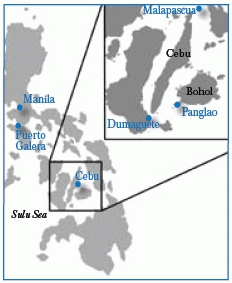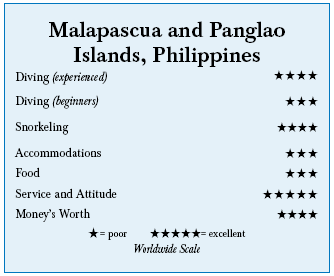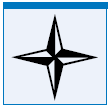Malapascua and Panglao, PhilippinesContents of this Issue: Reef’s End Lodge, Tobacco Caye, Belize Malapascua and Panglao, Philippines More Philippine Dive Resort Picks Freak Wave Capsizes Shark Boat, Kills Three Divers The Art of Underwater Photography Editorial Office: Ben Davison Publisher and Editor Undercurrent 3020 Bridgeway, Suite 102 Sausalito, CA 94965 inexpensive diving on diverse reefs from the May, 2008 issue of Undercurrent
Dear Reader: Now that the U.S. dollar is in freefall, the Philippines should be on every diver’s radar screen. One can get a week or more of good diving and accommodations for under $1,000 (airfare from Los Angeles is another $1,000). That’s less than many Caribbean venues, though considerably more rustic. Furthermore, the reefs are among the world’s most diverse, supporting more than 2,000 species of fish. English is widely spoken –- and the people like Americans. One reason I went was to see thresher sharks near Malapascua, where they can be seen regularly, or so they say. The latter half of my nine-day trip was at Panglao, attached to the island of Bohol east of Cebu. After arriving in Manila, I flew to the port city of Cebu and had a 6 a.m. pickup by private car, arranged by Divelink, a Cebubased operation. A three-hour drive north on a narrow coastal road led me to a small private boat for the half-hour cruise to the small island of Malapascua. While self-appointed beachside valets schlepped my bags to Sunsplash Resort, my divemaster, Danny, a chubby, fiftyish, barefoot local, escorted me along the powdery beach to the dive shop. We passed small resorts serving breakfast al fresco, while masseuses oiled down European tourists on beach towels. There are no streets or cars on Malapascua, only motorbikes puttering down sandy paths. At Divelink’s shop, a small, two-story mahogany building under construction, Danny announced we would start with a 5 a.m. dive at Monad Shoals to see thresher sharks. If we didn’t see them then, we’d go again at the 2 p.m. dive, then a sunset dive at the Lighthouse for mandarinfish. At the resort, Filipino desk clerk Jackie opened the door to my spotless, whitepainted room with a mosquito-netted, king-size bed flanked by tiny bedside stands, a desk with TV and DVD player, a stocked mini-fridge, cubicles with hangers, a combination safe and a bathroom with cold-water shower. Then she pointed to the AC. “Sorry, the electricity is off from 10 a.m. to 5 p.m.” A sweltering, unventilated room didn’t bode well for post-dive afternoon naps. James, Danny’s twentysomething son, hauled my gear away to have it ready for the morning dive. Divelink rinsed, dried and locked it up every night. At 4:45 a.m., the crew’s flashlights and cigarettes lit the path across the tide flats to the waiting canoe, Sea Saw. It hauled me, my dive buddy and our gear a few yards farther to the Princess of Malapascua, a 60-foot outrigger banca with life jackets, oxygen, cell phone, marine head and capacity for 20 divers but no dedicated camera area. By flashlight, Danny and James helped us set up gear, then offered hot coffee while Captain Fredo sped us a half-hour to Monad Shoals. The sun was fully up when Princess tied into a mooring line and Danny got out his whiteboard. “We giant stride off the bow, follow the line to 70 feet and wait on the edge of the depth zone for the thresher sharks. There are four cleaning stations. We stay down until you reach 750 psi. We do two safety stops, the first at 30 feet for five minutes and the second at 15 feet for five minutes.” I dropped into the 78-degree water with my aluminum 80 as two more boats tied up and disgorged a dozen divers. No threshers appeared. However, along the sea star- and sea urchin-filled reef, I enjoyed unicorn fish, raccoon butterfly fish, Moorish idols, a school of mackerel, trunkfish, and spine-cheek anemone fish cavorting in Merten’s anemones. Because the ladder didn’t extend into the water, I had to hand my weight belt, BC and fins to Fredo, who hauled me up. Afterward, I sat at Sunsplash’s shaded outdoor restaurant and inhaled its complimentary breakfast buffet: sausages, hot dogs, bacon, eggs, banana pancakes, Thai fried noodles, muesli, corn flakes, baguettes, mangoes, juice, instant coffee and tea.
Between dives, I lounged in the resort’s palmtreed courtyard, or waited behind German and Russian tourists checking email at the nearby Floating Island Japanese Restaurant and Internet Cafe. While Floating Island offered sushi, and beachside buffets abounded, I ate dinners at Sunsplash. The $12 buffet offered oily Filipino meats and veggies, overcooked schnitzels and pepper steaks (the owner is German), but cold San Miguel beer was $1, and the mango- and chocolate-filled crepe pleased my sweet tooth. At Gatos Island, an hour’s boat ride, I cavern-dived at 40 feet to see sleeping white-tip reef sharks, then played with a white stonefish, a cuttlefish as big as a housecat and two ornate ghost pipefish. Danny caught a four-foot-long banded sea snake behind its head and let it twine around his arm. Gatos Island’s hard and soft corals appaered healthier than those nearer Malapascua. At Lapus Lapus, on a gorgonian sea fan 72 feet down, Danny isolated a pygmy seahorse as small as a pinky fingernail that was the color of the sea fan’s tendrils it clutched. Between dives, I lunched on steamed white rice, dried fish, and canned corned beef eaten with my fingers, local-style. I was prepared to leave Malapascua thresher-less but happy. Danny consoled me. “Tomorrow, we try again. Maybe last day is lucky.” So after another early bedtime, I dropped into the sea, avoiding sea urchins and fire coral. Danny rotated his converted butter knife, but no shark responded to the reflection. Watching a long-nosed butterfly fish root on a brain coral, I heard Danny grunt and looked up. A 12-foot-long silver bullet swam 50 feet away. The thresher turned, revealing a dark tail half the length of its body, flicked it and disappeared. My only sighting lasted two seconds.
My young divemaster, Zaldy, conducted thorough briefings in excellent English for me and a typical batch of Germans, Danes, Slovenians, Russians, Taiwanese, Japanese and a Turk, all of whom smoked whenever regulators weren’t in their mouths. As on Malapascua, Bohol water temperatures were in the high 70s. The sites delivered on critter diversity. At Rudy’s Reef, jewel and red-cheeked basslets, purple anthias and blue chromis met me in the shallows lined with plump pink sea stars covered by chocolate chip-like projections. Along the fan- and crinoid-lined wall, golden basslets decorated pine green tubastria. Zaldy spotted a black frogfish in the shadows of a sea fan, and five grim-faced stonefish on identically colored rocks. Lionfish waved feathery fans like Las Vegas showgirls. A pair of batfish swam with us, poking expectantly at Zaldy’s empty hands. A wide-angle lens worked well on a vista of Emperor and blue-faced angelfish, harlequin and spotted sweetlips, fans and feather stars of all colors. Unlike Malapascua, Panglao diving is reef and wall diving, at both Alona Beach and the Balicasag Island marine sanctuary an hour away. Three dives a day followed a similar profile: a 20-foot free descent to a sandy slope, then a short swim to a wall that drops 80 feet to the sandy bottom. A miniscule current required so little effort that I invariably ascended after a 50-minute dive with my aluminum 80 still half full. That was especially frustrating on one dive when Zaldy surfaced the group after only 25 minutes because one diver, a petite but heavy-smoking female, ran out of air. I did four dives from a 25-diver capacity boat with three divemasters escorting only two or three divers or snorkelers. The boat carried oxygen, life jackets, a radio, a marine head, a cell phone and a statuette of El Santo Niño, but no area for cameras. Divemasters offered instant coffee or tea but I had to bring my own water and snacks. Cheerful young men hauled my gear on and off the boats. At Balicasag Island Marine Sanctuary, I swam among healthy soft cup and leather corals, and hard table, plate, brain, lettuce, staghorn and elkhorn corals in large, hearty formations. A green turtle nestled beneath a beer keg-shaped barrel sponge. Panglao diving reminds me of that in Palau and Pohnpei without the stiff currents; however, the reefs, especially those near the beach, were not in as good shape as in Micronesia. It hit me daily because vendors sold shells everywhere. Alona Beach is good for snorkelers; the house reef, 300 feet offshore, stretches along the entire beach. Alona’s night scene revolves around BBQ grills that sizzle up and down the beach. At Trudis’, I sampled garlic grilled prawns for $3.50 while my buddy opted for salad, spaghetti Bolognese, garlic bread and dessert -- for $3.75. My final evening started with an Aussie meat pie washed down with pineapple and mango shakes at Powder Keg Bar & Restaurant, followed by cappuccinos at Kamalag’s Italian trattoria, all for less than $10, including tip. With all this talk about recession, price is more important. When it comes to dive trips, I seldom add extras after I’ve paid the package price, but the ones I bought on this trip were great values. For veteran divers who’ve been around the block a few times, the central Philippines is a delight due to its inexpensive, warmwater diving with fish that could pose for an ID book. Tally it all up, and that’s hard to beat for a dive destination anywhere. -- N.M.
|

I want to get all the stories! Tell me how I can become an Undercurrent Online Member and get online access to all the articles of Undercurrent as well as thousands of first hand reports on dive operations world-wide
| Home | Online Members Area | My Account |
Login
|
Join
|
| Travel Index |
Dive Resort & Liveaboard Reviews
|
Featured Reports
|
Recent
Issues
|
Back Issues
|
|
Dive Gear
Index
|
Health/Safety Index
|
Environment & Misc.
Index
|
Seasonal Planner
|
Blogs
|
Free Articles
|
Book Picks
|
News
|
|
Special Offers
|
RSS
|
FAQ
|
About Us
|
Contact Us
|
Links
|
3020 Bridgeway, Ste 102, Sausalito, Ca 94965
All rights reserved.

 My logbook shows ditto marks for the next
two dives, averaging 60 feet, at Monad Shoals.
Fortunately, there’s more to Malapascua diving than
thresher sightings. On the sunset dive at Lighthouse,
three minutes from the shop, I descended 25 feet to
a floor littered with coral residue. Danny pointed
to a four-inch iridescent turquoise and orange male
mandarinfish and his harem of four females, less than
half his size. As they swam only a foot from my
mask, I clearly saw their triangular faces and smilelike
mouths. One female snuggled up to the male. They
swam side by side straight up, then separated like
Blue Angel pilots performing a fleur-de-lis, leaving
the evidence of their mating floating above. The male
darted back into the coral, then emerged to court
another female. I left the lovers and followed Danny
to see seahorses, rock lobster, octopus and a pink
frogfish. On board, Danny told me that mandarinfish
mate every sunset. No wonder they smile.
My logbook shows ditto marks for the next
two dives, averaging 60 feet, at Monad Shoals.
Fortunately, there’s more to Malapascua diving than
thresher sightings. On the sunset dive at Lighthouse,
three minutes from the shop, I descended 25 feet to
a floor littered with coral residue. Danny pointed
to a four-inch iridescent turquoise and orange male
mandarinfish and his harem of four females, less than
half his size. As they swam only a foot from my
mask, I clearly saw their triangular faces and smilelike
mouths. One female snuggled up to the male. They
swam side by side straight up, then separated like
Blue Angel pilots performing a fleur-de-lis, leaving
the evidence of their mating floating above. The male
darted back into the coral, then emerged to court
another female. I left the lovers and followed Danny
to see seahorses, rock lobster, octopus and a pink
frogfish. On board, Danny told me that mandarinfish
mate every sunset. No wonder they smile.  I returned to Cebu for the 2 p.m.
ferry to Bohol. Alona Divers met me at
the pier with a private car for the
ride past farms of rice and coconut to
tiny Panglao, connected by bridge to
Bohol’s southwestern tip. There I met
with Alona Divers manager Maritess,
while porters delivered my luggage
next door to Trudis’ Place. Dozens of
resorts, restaurants, bars, souvenir
stands, Internet cafes and dive shops
are strung along Alona Beach’s white
sand. At Trudis’ Place, my secondfloor
room had a queen bed, closet and
shelves, small desk, cable TV, AC, and
bathroom with intermittent hot water.
I draped my gear across the balcony
railing that overlooked a garbage
dump and shut the door against crowing
roosters and the aroma of burning
trash. At least the electricity stayed
on 24/7 and the price included breakfast of eggs, meat, bread or rice, fruit, juice and
hot drink.
I returned to Cebu for the 2 p.m.
ferry to Bohol. Alona Divers met me at
the pier with a private car for the
ride past farms of rice and coconut to
tiny Panglao, connected by bridge to
Bohol’s southwestern tip. There I met
with Alona Divers manager Maritess,
while porters delivered my luggage
next door to Trudis’ Place. Dozens of
resorts, restaurants, bars, souvenir
stands, Internet cafes and dive shops
are strung along Alona Beach’s white
sand. At Trudis’ Place, my secondfloor
room had a queen bed, closet and
shelves, small desk, cable TV, AC, and
bathroom with intermittent hot water.
I draped my gear across the balcony
railing that overlooked a garbage
dump and shut the door against crowing
roosters and the aroma of burning
trash. At least the electricity stayed
on 24/7 and the price included breakfast of eggs, meat, bread or rice, fruit, juice and
hot drink.  Diver’s Compass: Total land costs were $1,305 for both Malapascua and
Bohol, including all transfers except the ferry . . . ActiVentures,
a Philippine dive travel agency with offices in San Francisco,
California, and Cebu, created a custom package for me . . . Neither
Divelink nor Alona Divers offers Nitrox . . . Sunsplash rooms are $60
to $70, while at Trudis’ Place rates are $48 to $80 and include free
wireless Internet . . . Change money before leaving Manila for better
exchange rates . . . My international ticket allowed two checked
bags of 50 pounds each, but my domestic flight allowed only 44 pounds
total, so I had to pay 37 cents per pound above that; credit cards are OK. US citizens
need a passport valid for six months and can stay for 21 days without a visa .
. . On Bohol, Alona Divers and Trudis’ took plastic, but on Malapascua they only took
cash, preferably pesos, and money changers won’t convert pesos back to dollars . .
. At piers and airports, uniformed baggage handlers grab your luggage even without
your permission, so if you want to handle your own, order them to stop or they will
demand a tip; when I wanted my bags carried, I tipped $1 per bag . . . Electricity
was 220 volts; expect sparks when you plug in and use an adaptor with built-in surge
protector . . . Activentures:
Diver’s Compass: Total land costs were $1,305 for both Malapascua and
Bohol, including all transfers except the ferry . . . ActiVentures,
a Philippine dive travel agency with offices in San Francisco,
California, and Cebu, created a custom package for me . . . Neither
Divelink nor Alona Divers offers Nitrox . . . Sunsplash rooms are $60
to $70, while at Trudis’ Place rates are $48 to $80 and include free
wireless Internet . . . Change money before leaving Manila for better
exchange rates . . . My international ticket allowed two checked
bags of 50 pounds each, but my domestic flight allowed only 44 pounds
total, so I had to pay 37 cents per pound above that; credit cards are OK. US citizens
need a passport valid for six months and can stay for 21 days without a visa .
. . On Bohol, Alona Divers and Trudis’ took plastic, but on Malapascua they only took
cash, preferably pesos, and money changers won’t convert pesos back to dollars . .
. At piers and airports, uniformed baggage handlers grab your luggage even without
your permission, so if you want to handle your own, order them to stop or they will
demand a tip; when I wanted my bags carried, I tipped $1 per bag . . . Electricity
was 220 volts; expect sparks when you plug in and use an adaptor with built-in surge
protector . . . Activentures: 